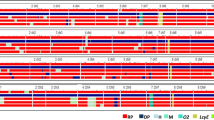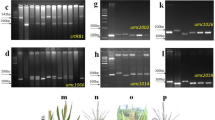Abstract
Phytic acid (PA) is an important antinutritional component in maize that affects the availability of major micro-nutrients like di- and multi-valent mineral cations like iron (Fe) and zinc (Zn). The long-term consumption of maize as a staple food crop leads to micronutrient malnutrition especially iron and zinc deficiency in the human population. In addition, it also acts as a storehouse of a major part of mineral phosphorous (P), approximately 80% of the total P stored as phytate P is not available to mono-gastric animals like humans and poultry birds, and it gets excreted as such, leading to one of the major environmental pollution called eutrophication. Of the various low phytic acid (lpa) mutants, lpa2-2 generated through mutagenesis reduces PA by 30%. BML 6 and BML 45, the parents of the popular maize hybrid DHM 121 with high PA were selected to introgress lpa2-2 through marker-assisted backcross breeding (MABB). The percent recurrent parental genome (RPG) in the selected BC2F2 plants ranged from 88.68 to 91.04% and 90.09–91.51% in the genetic background of BML 6 and BML 45, respectively. Based on the highest percentage of RPG, best five BC2F2 plants, viz., #3190, #3283, #3230, #3263 and #3292 with RPG 88.68–91.04% in the genetic background of BML 6 and #3720, #3776, #3717, #3828 and #3832 with RPG 90.09–91.51% in the genetic background of BML 45 were advanced to BC2F3. The newly developed near-isogenic lines (NILs) possessed low phytate content (2.37 mg/g in BML 6 and 2.40 mg/g in BML 45) compared to 3.59 mg/g and 3.16 mg/g in recurrent parents BML 6 and BML 45, respectively thereby reducing the phytate by an average of 34 and 24 per cent, respectively. These newly developed progenies were similar to their recurrent parents for various morphological traits. These inbreds assume great significance in alleviating Fe and Zn deficiencies in worldwide.






Similar content being viewed by others
Data availability
The datasets generated during and/or analysed during the current study are available from the corresponding author on reasonable request.
References
Anderson BP, Fehr WR (2008) Seed source affects field emergence of low-phytate soybean lines. Crop Sci 48:929–932. https://doi.org/10.2135/cropsci2007.09.0510
Arunakumari K, Durgarani CV, Satturu V et al (2016) Marker-assisted pyramiding of genes conferring resistance against bacterial blight and blast diseases into indian rice variety MTU1010. Rice Sci 23:306–316. https://doi.org/10.1016/J.RSCI.2016.04.005
Bhatt V et al (2018) Development of low phytic acid maize through marker-assisted introgression of lpa1-1 and lpa2-1 genes, in: Abstracts: 13th Asian Maize Conference on and Expert Consultation on Maize for Food, Feed, Nutrition and Environmental Security, Ludhiana, India, October 8-10, 2018 (Mexico: CIMMYT): 143–144
Brinch-Pedersen H, Sørensen LD, Holm PB (2002) Engineering crop plants: getting a handle on phosphate. Trends Plant Sci 7:118–125. https://doi.org/10.1016/S1360-1385(01)02222-1
CerinoBadone F, Amelotti M, Cassani E, Pilu R (2012) Study of low Phytic Acid1-7 (lpa1-7), a New ZmMRP4 mutation in maize. J Hered 103:598–605. https://doi.org/10.1093/JHERED/ESS014
Dellaporta SL, Wood J (1983) Hicks JB (1983) A plant DNA minipreparation: Version II. Plant Mol Biol Report 14(1):19–21. https://doi.org/10.1007/BF02712670
Elilis DL, Pantalone VR (2009) Induced plant mutations in the genomic era. FAO 34:316-318. https://www.fao.org/3/i0956e/i0956e00.htm.
Herzog E, Frisch M (2011) Selection strategies for marker-assisted backcrossing with high-throughput marker systems. Theor Appl Genet 123:251–260. https://doi.org/10.1007/S00122-011-1581-0
Hospital F (2001) Size of donor chromosome segments around introgressed loci and reduction of linkage drag in marker-assisted backcross programs. Genetics 158:1363–1379. https://doi.org/10.1093/GENETICS/158.3.1363
Joshi RK, Nayak S (2010) Gene pyramiding-A broad spectrum technique for developing durable stress resistance in crops. Biotechnol Mol Biol Rev 5:51–60
Lorenz AJ, Scott MP, Lamkey KR (2007) Quantitative determination of phytate and inorganic phosphorus for maize breeding. Crop Sci 47:600–604. https://doi.org/10.2135/CROPSCI2006.03.0177
Maupin LM, Rosso ML, Rainey KM (2011) Environmental effects on soybean with modified phosphorus and sugar composition. Crop sci 51(2):642–650
Naidoo R, Watson GMF, Derera J et al (2012) Marker-assisted selection for low phytic acid (lpa1-1) with single nucleotide polymorphism marker and amplified fragment length polymorphisms for background selection in a maize backcross breeding programme. Mol Breed 2:1207–1217. https://doi.org/10.1007/S11032-012-9709-8
Oltmans SE, Fehr WR, Welke GA et al (2005) Agronomic and seed traits of soybean lines with low–phytate phosphorus. Crop Sci 45:593–598
Prasanna BM, Palacios-Rojas N, Hossain F et al (2020) Molecular breeding for nutritionally enriched maize: status and prospects. Front Genet 10:1392. https://doi.org/10.3389/FGENE.2019.01392/BIBTEX
Raboy V (2002) Progress in breeding low phytate crops. J Nutr. https://doi.org/10.1093/JN/132.3.503S
Raboy V (2007) The ABCs of low-phytate crops. Nat Biotechnol 258(25):874–875. https://doi.org/10.1038/nbt0807-874
Raboy V (2020) Low phytic acid crops: observations based on four decades of research. Plants. https://doi.org/10.3390/plants9020140
Raboy V, Hudson SJ, Dickson DB (1985) Reduced phytic acid content does not have an adverse effect on germination of soybean seeds. Plant physiol 79(1):323–325
Raboy V, Gerbasi PF, Young KA et al (2000) Origin and seed phenotype of maize low phytic acid 1–1 and low phytic acid 2–1. Plant Physiol 124:355–368. https://doi.org/10.1104/PP.124.1.355
Rouf Shah T, Prasad K, Kumar P (2016) Maize—A potential source of human nutrition and health: A review. http://www.editorialmanager.com/cogentagri 2:. https://doi.org/10.1080/23311932.2016.1166995
Scaboo AM, Pantalone VR, Walker DR et al (2009) Confirmation of molecular markers and agronomic traits associated with seed phytate content in two soybean RIL populations. Crop sci. 49(2):426–432
Shi J, Wang H, Wu Y et al (2003) The maize low-phytic acid mutant lpa2 is caused by mutation in an inositol phosphate kinase gene. Plant Physiol 131:507–515. https://doi.org/10.1104/PP.014258
Shi J, Wang H, Hazebroek J et al (2005) The maize low-phytic acid 3 encodes a myo-inositol kinase that plays a role in phytic acid biosynthesis in developing seeds. Plant J 42:708–719. https://doi.org/10.1111/J.1365-313X.2005.02412.X
Shi J, Wang H, Schellin K et al (2007) Embryo-specific silencing of a transporter reduces phytic acid content of maize and soybean seeds. Nat Biotechnol 258(25):930–937. https://doi.org/10.1038/nbt1322
Singh BD, Singh AK (2015) Marker-Assisted Selection. In: Singh BD, Singh AK (eds) Marker-Assisted Plant Breeding: Principles and Practices. Springer India, New Delhi, pp 259–293. https://doi.org/10.1007/978-81-322-2316-0_9
Spear JD, Fehr WR (2007) Genetic improvement of seedling emergence of soybean lines with low phytate. Crop Sci. 47(4):1354–1360
Sureshkumar S, Tamilkumar P, Senthil N et al (2014a) Marker assisted selection of low phytic acid trait in maize (Zea mays L.). Hereditas 151:20–27. https://doi.org/10.1111/J.1601-5223.2013.00030.X
Sureshkumar S, Tamilkumar P, Thangavelu AU et al (2014b) Marker-assisted introgression of lpa2 locus responsible for low-phytic acid trait into an elite tropical maize inbred (Zea mays L.). Plant Breed 133:566–578. https://doi.org/10.1111/PBR.12185
Tamilkumar P, Senthil N, Sureshkumar S et al (2014) Introgression of low phytic acid locus (lpa2-2) into an elite Maize (Zea mays L.) inbred through marker assisted backcross breeding. AJCS 8:1224–1231
Wilcox JR, Premachandra GS, Young KA, Raboy V (2000) Isolation of high seed inorganic p, low-phytate soybean mutants. Crop Sci 40:1601–1605. https://doi.org/10.2135/CROPSCI2000.4061601X
Acknowledgements
The authors acknowledge Dr. R. K. Khulbe and ICAR-Vivekananda Parvatiya Krishi Anusandhan Sansthan, Almora for sharing lpa2 donor under CRPMB Project. The author also acknowledge the PJTSAU, Hyderabad for sharing the recurrent parental lines BML 6 and BML 45 for conversion through MABB, The author also acknowledge Dr. A. K. Singh, Director, ICAR-Indian Agricultural Research Institute and also the Project Coordinator, CRPMB and Dr. D. K. Yadava, ADG (Seed), ICAR for their support and guidance while undertaking the project.
Funding
This work is supported by the Indian Council of Agricultural Research (ICAR) under Consortium Research Platform on Molecular Breeding (CRPMB) Project.Indian Council of Agricultural Research
Author information
Authors and Affiliations
Contributions
Conceptualization and investigation of work by CGK and YKR. The experiments and studies are conducted by YKR, SSG. Part of the experimental work was also supported by AK, P J, H K Y, and S S. The data analysis was done by HK MS and SK. The first draft of the manuscript was written by YKR and CGK. The manuscript was imporved by SR, AS, JCS, RNG, RKP, FH, and AKD. All authors read and approved the manuscript.
Corresponding author
Ethics declarations
Conflict of interests
All the authors declare no competing interests.
Additional information
Publisher's Note
Springer Nature remains neutral with regard to jurisdictional claims in published maps and institutional affiliations.
Supplementary Information
Below is the link to the electronic supplementary material.
Rights and permissions
Springer Nature or its licensor holds exclusive rights to this article under a publishing agreement with the author(s) or other rightsholder(s); author self-archiving of the accepted manuscript version of this article is solely governed by the terms of such publishing agreement and applicable law.
About this article
Cite this article
Yathish, K.R., Karjagi, C.G., Gangoliya, S.S. et al. Introgression of the low phytic acid locus (lpa2) into elite maize (Zea mays L.) inbreds through marker-assisted backcross breeding (MABB). Euphytica 218, 127 (2022). https://doi.org/10.1007/s10681-022-03076-y
Received:
Accepted:
Published:
DOI: https://doi.org/10.1007/s10681-022-03076-y




